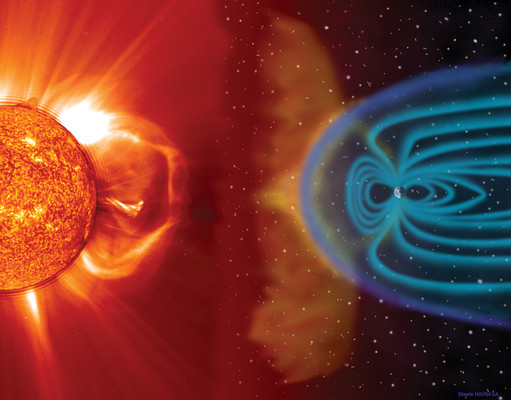
by Carolyn Gramling Thursday, January 5, 2012

Small changes in the movement of the molten iron in Earth's outer core cause parts of the magnetic field (blue lines) to fluctuate. The field protects the planet from solar flares. NASA
Since 1999, the German satellite CHAMP (CHAllenging Mini-satellite Payload) has swirled around Earth, keeping watch as the planet’s magnetic field waxes and wanes over time. CHAMP’s continuous measurements of Earth’s field have created a finely detailed picture of how the field changes both in space and in time — and by extension, how the movement of the molten iron in Earth’s outer core ebbs and flows. And thanks to these data, researchers report, they can now track even small-scale, rapid fluctuations in the field’s strength around the planet.
Molten iron moving in Earth’s core generates the planet’s magnetic field, which protects the planet against solar flares and other space weather. The strength of Earth’s magnetic field is known to fluctuate on very long time scales; on rare occasions, the field has even reversed polarity, in which the magnetic north pole and magnetic south pole switch places. (The last such reversal was about 780,000 years ago.)
The nine years of continuous magnetic field data from CHAMP and the satellites Ørsted and SAC-C paint a surprising portrait of small-scale fluctuations in the field, report researchers Nils Olsen of the Danish National Space Center in Copenhagen and Mioara Mandea of the GFZ Potsdam in Germany May 18 in Nature Geoscience. The strongest magnetic changes, they found, aren’t global, but are located in the Southern Hemisphere, spanning the Atlantic and Indian oceans.
The changes in fluid motion that are responsible for the field fluctuations are occurring right at the boundary between the core and mantle about 2,900 kilometers below Earth’s crust, the researchers say. With the new model, the researchers tracked the movement of that fluid deep inside Earth: For example, the model showed the flow accelerating southward beneath Asia in May 2003, then taking a sharp westward tack across the Indian Ocean before weakening.
What causes these short-term, local fluctuations isn’t yet clear, they say. But thanks to these satellite observations, scientists now have a new window into movement in the core — and into what drives Earth’s geodynamo.
© 2008-2021. All rights reserved. Any copying, redistribution or retransmission of any of the contents of this service without the expressed written permission of the American Geosciences Institute is expressly prohibited. Click here for all copyright requests.